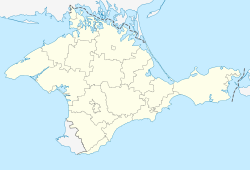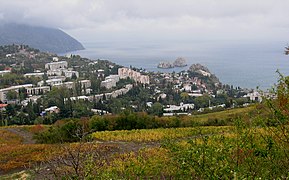Gurzuf (original) (raw)
From Wikipedia, the free encyclopedia
Urban-type settlement in Crimea
| Gurzuf Гурзуф | |
|---|---|
| Urban-type settlement | |
 Flag Flag Coat of arms Coat of arms |
|
  GurzufLocation of Hurzuf within CrimeaShow map of Ukraine GurzufLocation of Hurzuf within CrimeaShow map of Ukraine  GurzufLocation of Hurzuf within the Black SeaShow map of Crimea GurzufLocation of Hurzuf within the Black SeaShow map of Crimea |
|
| Coordinates: 44°33′10″N 34°17′15″E / 44.55278°N 34.28750°E / 44.55278; 34.28750 | |
| Republic | Crimea |
| Municipality | Yalta Municipality |
| Elevation | 30 m (100 ft) |
| Population (2014) | |
| • Total | 8,933 |
| Time zone | UTC+3 (MSK) |
| Postal code | 98640 — 98643 |
| Area code | +7-654 |
| Former names | Gorsovium, Gorzubiti |
| Climate | Cfa |
Gurzuf or Hurzuf (Ukrainian: Гурзуф, Russian: Гурзу́ф, Crimean Tatar: Gurzuf, Greek: Γορζουβίται) is a resort town (urban-type settlement) in Yalta Municipality of the Autonomous Republic of Crimea, a territory recognized by a majority of countries as part of Ukraine but incorporated by Russia as the Republic of Crimea. Population: 8,933 (2014 Census).[1]
It is located on the northern coast of the Black Sea. It is the site of a 6th-century fortress built by Justinian I and called by Procopius the fortress of the Gorzoubitai. The fortress was later restored by the Genoese who called the place Garzuni, Grasni, and Gorzanium, and appointed it the seat of a chief magistrate.[2] It was a former Crimean Tatar village, now a part of Greater Yalta. Alexander Pushkin visited Gurzuf in 1820 and ballet master Marius Petipa died here. The International Children's Center Artek (formerly the All-Union Young Pioneer camp Artek) is situated just behind Mount Ayu-Dag (Bear Mountain). The World Organization of the Scout Movement's Eurasian Region is headquartered in the town.
Between Gurzuf and Mount Ayu-Dag is Cape Suuksu. At the top of the Cape is a tower, a medieval cemetery, and a small monument to Pushkin.
The origin of the name is not reliably established. Some researchers believe that it comes from the Latin Ursus "bear", as the "Bear Mountain" (Ayu-Dag) is located near the town. Others believe that the name Horzuv, Horzuvaty has Taurian or Gotho-Alan roots and decipher it as "gor dzakkh" - mountain valley, valley among the mountains.[3] Gradually, the place name "Gorzuvyti" was transformed into Kursaity, Gorzovium, Yurzuf, and Gurzuf.
- Cengiz Dağcı (1919–2011), Crimean Tatar novelist and poet
- Mansur Mazinov (1906–1983), Soviet air force officer, the first Crimean Tatar pilot
- Natalia Popovych (born 1968), Ukrainian politician
View of Gurzuf- [
 ](/wiki/File:Goddess%5Fof%5FNight,%5FGurzuf,%5FCrimea.jpg ""Goddess of Night" fountain in Gurzuf")
](/wiki/File:Goddess%5Fof%5FNight,%5FGurzuf,%5FCrimea.jpg ""Goddess of Night" fountain in Gurzuf")
"Goddess of Night" fountain in Gurzuf 
Statue
Statue- [
](/wiki/File:Korovin%5Fpier%5Fin%5FGurzuf.JPG ""Pier in Gurzuf" by Konstantin Korovin, 1914")
"Pier in Gurzuf" by Konstantin Korovin, 1914 
Gurzuf in the fall
- ^ Russian Federal State Statistics Service (2014). "Таблица 1.3. Численность населения Крымского федерального округа, городских округов, муниципальных районов, городских и сельских поселений" [Table 1.3. Population of Crimean Federal District, Its Urban Okrugs, Municipal Districts, Urban and Rural Settlements]. Федеральное статистическое наблюдение «Перепись населения в Крымском федеральном округе». ("Population Census in Crimean Federal District" Federal Statistical Examination) (in Russian). Federal State Statistics Service. Retrieved January 4, 2016.
- ^ John Buchan Telfer. The Crimea and Transcaucasia. Forgotten Books, 2012. p.68.
- ^ "История Гурзуфа". krim.biz.ua. Retrieved 2023-04-04.
